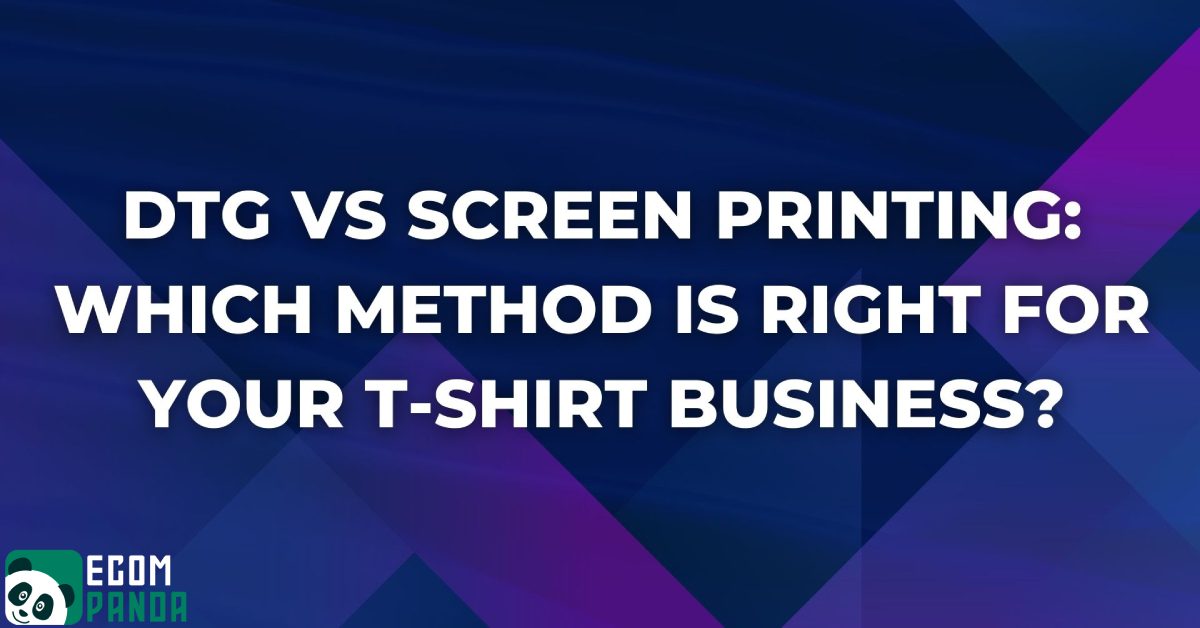Introduction
In the dynamic world of the T-shirt business, understanding the varied printing methods can be the key to success. One of the most common questions that entrepreneurs grapple with is, “DTG vs screen printing: which method should I use?” Each method has its own strengths and weaknesses and determining the most suitable one for your business often depends on a variety of factors.
The importance of choosing the right printing method for your T-shirt business cannot be understated. It can significantly affect the quality of your products, your production capacity, costs, and ultimately, your customer satisfaction. Therefore, it’s crucial to have a clear understanding of both Direct to Garment (DTG) and screen printing techniques to make an informed decision.
This article will delve into the nitty-gritty of both DTG and screen printing, comparing their benefits and limitations. We’ll also discuss the specific scenarios where one might be more suitable over the other. So, whether you’re just starting out or looking to refine your current printing process, this “DTG vs screen printing” overview will provide you with the necessary insight to choose the method that aligns best with your business goals.
Table of Contents

Understanding T-Shirt Printing Methods: DTG vs Screen Printing
When it comes to printing on T-shirts, Direct to Garment (DTG) and Screen Printing are two of the most popular methods utilized by businesses. However, each of these methods has unique characteristics that set them apart.
DTG printing, as the name suggests, involves a printer directly applying the ink to the fabric of the T-shirt. It’s quite akin to how your standard paper printer works, except in this case, the “paper” is a piece of clothing. The printer uses specialty inks that are absorbed by the fibers of the garment. DTG is known for its ability to capture intricate details and a wide array of colors, making it ideal for complex, multicolored designs.
On the other hand, Screen Printing, also known as silkscreen or serigraphy, is a method that has been around for thousands of years. It involves creating a stencil, or “screen,” for each color used in the design. The ink is then pushed through these stencils onto the fabric. This method can produce highly durable and vibrant prints but is often best suited for designs with a limited color palette due to the process of creating individual screens for each color.
When we put “DTG vs screen printing” head-to-head, several differences emerge. DTG stands out with its ability to print highly detailed, multicolored designs with a short setup time. However, screen printing shines in situations where large orders need to be fulfilled or when a design uses a few solid colors, due to its cost-effectiveness and vibrant, durable results. The choice between the two often depends on your specific business needs and the type of designs you plan to print.
How to Choose Between DTG and Screen Printing
Deciding between DTG and screen printing for your T-shirt business can be a challenging task. Several factors come into play, including design complexity, color variety, production volume, and budget.
Design complexity and color variety are major considerations in the “DTG vs screen printing” debate. If your designs are intricate and multicolored, DTG might be the best choice. This method uses a printer to spray ink directly onto the garment, effectively replicating the design exactly as it appears on your computer. This process allows for a virtually unlimited color palette and a high level of detail.
On the contrary, screen printing involves creating individual screens for each color in your design. This process is most cost-effective and efficient when you’re working with simpler designs that have fewer colors. Screen printing can deliver vibrant, solid color prints and is known for producing durable results, but intricate and multicolored designs can be complex and time-consuming to screen print.
Production volume is another crucial factor. For smaller orders or samples, DTG usually prevails due to its lower setup time and costs. There’s no need for screens or color separations; the design goes straight from your computer to the printer. However, for larger orders, screen printing often becomes more cost-effective. Once the screens are created, the printing process is fast, and the cost per unit decreases with volume.
The budget of your T-shirt business is the final consideration in the “DTG vs screen printing” decision. Screen printing has higher setup costs and is more time-consuming initially, especially for complex, multicolored designs. However, it becomes cheaper per unit with larger orders. Conversely, DTG has lower setup costs, making it more affordable for small batches or single samples, but the cost per shirt remains consistent, no matter how many you print.
In summary, DTG tends to excel for small orders, complex and multicolored designs, and when rapid design changes are needed. Screen printing, on the other hand, is more suitable for larger orders, designs with fewer colors, and when durability is a top priority. Each method has its strengths and weaknesses, and the choice between “DTG vs screen printing” ultimately comes down to your specific business model and customer needs.
DTG Printing: Benefits and Limitations
DTG, or Direct to Garment printing, has revolutionized the T-shirt printing industry with its versatility and convenience. Let’s take a deep dive into the benefits and limitations of this method.
Benefits of DTG Printing
Versatility in Design and Color: DTG printing allows for high-resolution prints with unlimited color options. You can reproduce intricate, multicolored designs on your T-shirts with exceptional detail, a task that can be challenging for traditional printing methods.
Short Set-Up Time: With DTG printing, there’s no need for screens or color separations. The design goes straight from your computer to the printer, which translates to a shorter setup time and faster turnaround.
Suitability for Small Batches: Given the minimal setup required, DTG printing is ideal for small batch orders or even single pieces. This makes it perfect for businesses that offer personalized products or operate on a print-on-demand model.
Limitations of DTG Printing
Higher Cost Per Unit: While DTG printing has lower setup costs, the cost per unit is generally higher than other printing methods like screen printing, especially when dealing with large volume orders.
Less Vibrancy for Some Colors: While DTG can reproduce a wide array of colors, some hues, particularly neon and very bright colors, may not be as vibrant as when they are screen printed.
Potential for Lower Print Durability: While DTG prints can maintain their quality for a good number of washes, they might not have the same longevity or durability as screen printed designs.
The “DTG vs screen printing” question largely boils down to your specific needs and priorities. If versatility, detailed designs, and small batch production are at the top of your list, DTG printing is likely the better choice for your T-shirt business. However, if cost-effectiveness for large orders and vibrant color reproduction are more important, screen printing might be more suitable.
Screen Printing: Benefits and Limitations
Screen printing, a time-honored method in the T-shirt printing industry, offers a range of benefits but also has its share of limitations. Let’s explore these in detail.
Benefits of Screen Printing
Lower Cost Per Unit for Large Orders: For bulk orders, screen printing is generally the most cost-effective method. Once the initial screens are created, additional shirts can be printed at a relatively low cost. The cost per unit decreases significantly with volume, making this method ideal for large batch orders.
Excellent Vibrancy: Screen printing offers unmatched vibrancy, especially when printing on dark fabrics. The inks used in screen printing are thicker, resulting in deeply saturated, standout colors.
Print Durability: The durability of screen-printed T-shirts is one of the key benefits of this method. Screen prints can withstand countless washes without losing their color intensity, an essential factor for producing long-lasting designs.
Limitations of Screen Printing
Complex Set-Up Process: The initial setup for screen printing can be time-consuming and complex. Each color in the design requires a separate screen, making it a less suitable option for designs with multiple colors or intricate patterns.
Not Suitable for Highly Detailed Designs or Large Color Palette: If your designs are highly detailed or use a large array of colors, screen printing might not be the best method. It can be challenging and expensive to accurately replicate complex designs with screen printing due to the need for individual screens for each color.
Less Economical for Small Orders: Due to the initial setup costs, screen printing is not typically cost-effective for small orders. It’s more suited for bulk production.
In the “DTG vs screen printing” debate, screen printing stands out for large volume orders, designs with fewer but vibrant colors, and when print durability is critical. However, if you’re dealing with highly detailed or multicolored designs and smaller batches, DTG might be a better fit for your T-shirt business.
“DTG vs Screen Printing”: Practical Examples and Case Studies
In the discussion of “DTG vs screen printing,” real-world examples and case studies can provide valuable insight. Let’s consider some practical applications of both methods to better understand their implications for different business scenarios.
Case Study 1: Small-Scale Custom T-Shirt Business
Let’s imagine a small-scale T-shirt business specializing in personalized designs. Customers can order a single T-shirt with a unique design that includes a high level of detail and a multitude of colors. In this case, DTG printing would be the optimal choice. The cost-effectiveness of DTG for small batches, combined with its capability to accurately print complex, multi-colored designs, makes it perfectly suited for such a business model.
Case Study 2: Large-Scale T-Shirt Business with Simple Designs
On the other hand, let’s consider a large-scale T-shirt business that specializes in bulk orders of simple, one or two-color designs. Here, screen printing would be the most beneficial method. Screen printing’s cost per unit decreases with larger orders, and it excels in printing vibrant, solid colors. This method would also ensure that the printed T-shirts are durable and long-lasting, meeting the needs of a business producing large quantities.
Case Study 3: Hybrid Business Model
Lastly, let’s examine a hybrid T-shirt business that caters to both individual custom orders and large-scale production for corporate events. This business could effectively use both DTG and screen printing depending on the order specifics. For the individual custom orders or small batches, DTG would be the go-to method due to its low setup costs and design flexibility. For the large-scale, simpler designs, screen printing would be utilized for its cost-effectiveness and vibrancy in large quantities.
Through these examples, it’s clear that the “DTG vs screen printing” decision heavily depends on your business model, order volume, design complexity, and budget. By understanding the strengths and weaknesses of both methods, you can select the most suitable method for each situation, thereby maximizing efficiency and customer satisfaction.
| Factor | DTG Printing | Screen Printing |
|---|---|---|
| Design Complexity | Capable of printing highly detailed and intricate designs. | Better for simpler designs; complex designs can be challenging and costly. |
| Color Variety | Can handle unlimited color options and gradients with ease. | Limited color palette. Each color requires a separate screen. |
| Set-Up Time | Minimal setup time; design goes directly from computer to printer. | Requires more setup time, especially for multi-colored designs. |
| Cost Efficiency | More cost-effective for small orders; fixed cost per unit. | Cost-effective for large orders; cost per unit decreases with volume. |
| Print Vibrancy | Good, but may struggle with extremely bright or neon colors. | Exceptional vibrancy, especially with solid colors. |
| Print Durability | Good durability, but may fade faster than screen prints over time. | Known for excellent durability; prints can withstand numerous washes. |
| Production Volume | Ideal for small orders or print-on-demand due to low setup costs. | More suitable for large orders due to lower cost per unit with volume. |
| Material Versatility | Works well on a variety of materials but best results on lighter fabrics. | Works well on a range of materials and offers excellent results on dark fabrics. |
| Production Speed | Slower production speed, better suited for small batches. | Once screens are made, the process is quick, which is ideal for large batches. |
| Environmental Impact | Uses water-based inks; less wastage as it’s print-on-demand. | More ink waste and uses plastisol inks; however, advancements are being made to reduce environmental impact. |
Conclusion: Determining the Right Method for Your T-Shirt Business
In the journey to establish a successful T-shirt business, one of the most significant decisions you’ll make involves the printing method you choose. Throughout this article, we’ve examined the “DTG vs screen printing” question, delving into the intricacies of each method and exploring their respective benefits and limitations.
DTG, with its capability to print highly detailed and multicolored designs, stands out for its versatility and suitability for small batches or one-off prints. Conversely, screen printing, known for its cost-effectiveness in large orders, vibrancy, and print durability, excels when dealing with larger volumes and designs with fewer colors.
However, choosing between DTG and screen printing isn’t a matter of determining which method is universally better. Instead, it’s about understanding which method aligns best with your specific business model, customer demands, and future plans.
Are you working with complex, multicolored designs or a print-on-demand model? DTG might be the way to go. Are you planning to print large quantities of T-shirts with simple designs, aiming for vibrant colors and durable prints? In this case, screen printing could be the better choice.
In conclusion, understanding the characteristics of “DTG vs screen printing” and how they fit into your business strategy is crucial. As you weigh the pros and cons of each method, remember that the ultimate goal is to deliver quality products that meet your customers’ needs and expectations while maintaining business efficiency.
Frequently Asked Questions
1. Is screen printing or DTG better?
Neither method is universally better; it depends on your specific needs. Screen printing is generally more cost-effective for larger orders and offers more vibrant colors, especially on dark fabrics. On the other hand, DTG is more suitable for smaller orders or print-on-demand businesses due to its low setup costs, and it excels in printing highly detailed, multicolored designs.
2. Is DTG cheaper than screen printing?
DTG can be cheaper than screen printing for small orders because it has minimal setup costs. However, for larger orders, the cost per unit is generally lower for screen printing. Therefore, the cheaper method depends on the size of your order and the complexity of your design.
3. What is better quality: screen printing or digital printing?
Both methods can produce high-quality prints, but they excel in different areas. Screen printing offers outstanding vibrancy and durability, especially for solid colors. Digital printing (DTG) can reproduce highly detailed, intricate designs with a vast array of colors. The choice between the two largely depends on your specific needs and priorities.
4. Is screen printing better quality?
Screen printing is known for its excellent print durability and vibrancy. The prints can withstand countless washes without losing their color intensity. However, it can be challenging to print highly detailed or multicolored designs using this method. So, in terms of quality, screen printing excels in color vibrancy and durability, while DTG shines in design detail and color variety.
5. Is DTG long-lasting?
DTG prints can maintain their quality for a good number of washes, but they may not be as durable as screen prints, particularly when subjected to rigorous washing conditions. The longevity of DTG prints can also be influenced by the quality of the ink used, the material of the T-shirt, and the post-printing treatment process.







